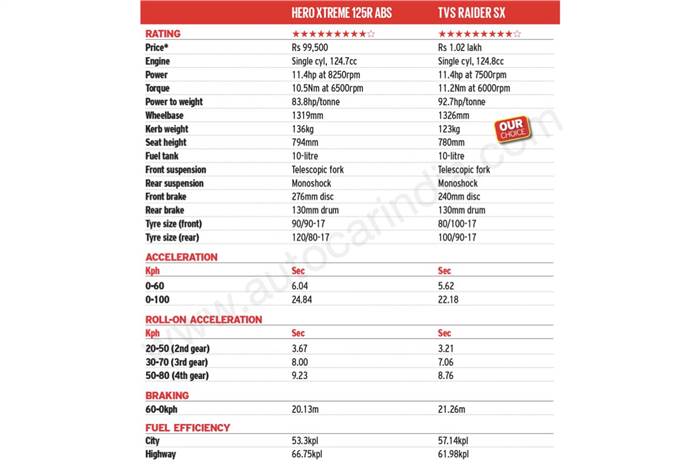These 125s promise the practicality of a commuter with the desirability of more premium machines. We suggest which one is right for you.
The TVS Raider was the first 125cc motorcycle that said, ‘yes, you can have a sensible and cost effective commuter, but it can also be fun and desirable’. That formula led to it winning our Bike of the Year award in 2021 and the Raider has subsequently become TVS’ bestselling motorcycle in a really short span of time. It’s such a great success story that Hero is going down a similar route with the new Xtreme 125R.
AT FIRST SIGHT
In fact, when it comes to giving off premium bike vibes, the Xtreme even outdoes the Raider. With its aggressive headlamp, sculpted fuel tank, large side shrouds and sporty tail, you could easily mistake this bike for a 160, and the Xtreme scores big in this regard. The Raider is still a very stylish motorcycle, but it does look a little more petite in this company.
Both do more than simply try to look like larger machines and they also offer you a more premium feature set than you would find on the typical 125cc commuter. For example, both have good looking LED headlamps that light up a road well at night. Both also have fully digital displays, nice switchgear, monoshock rear suspension and 5-speed gearboxes.
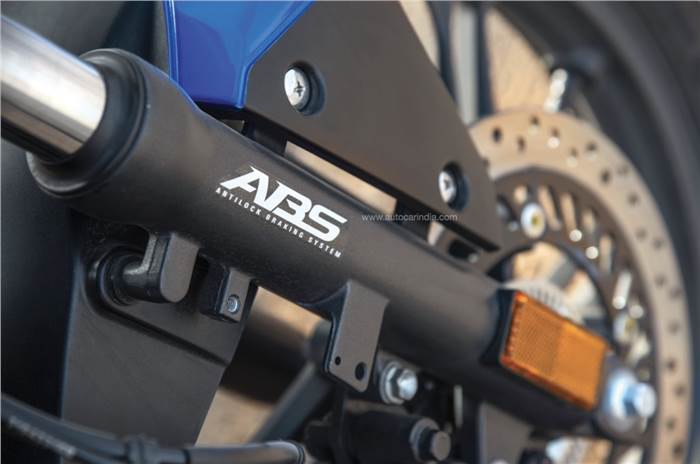
The Xtreme strikes back with segment-first ABS.
The Hero’s USP is that it is the only bike in the segment that comes with the choice of single channel ABS, which deserves praise. However, the Raider gives you more in terms of sheer features, including two riding modes, a start-stop system, a silent engine start, and a USB charging port. On top of that, the highest-spec Raider SX is the only bike in the segment that comes with the choice of a Bluetooth-compatible TFT display.
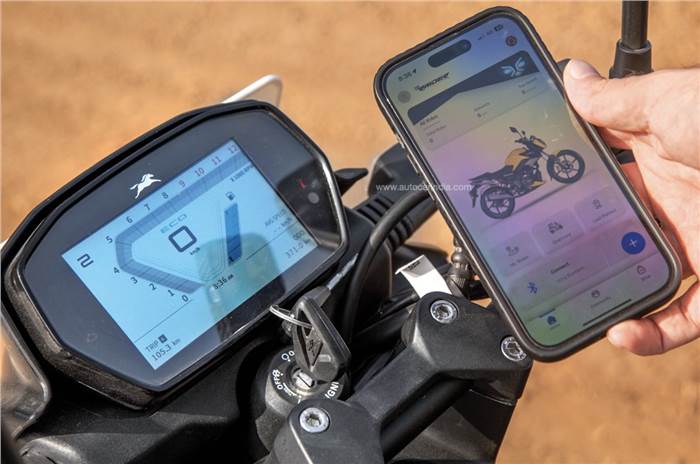
Raider’s USP is a Bluetooth-compatible TFT display.
This TFT looks clean and crisp and it’s a great feeling to glance down and see such an expensive looking display. However, it is a little slow to respond and I find that the gear position indicator isn’t very accurate. The display also has an annoying feature where it keeps scrolling a multitude of generic safety messages at the rider whenever the bike comes to a halt at a traffic signal – whether the engine is on or off. At first this is a nice touch, but it quickly gets old and almost feels like you’re being nagged by your bike on how you should be riding. Unfortunately, this can’t be turned off, but TVS says that if you connect to the smartphone app, the screen will show you sports or news updates in that space instead.
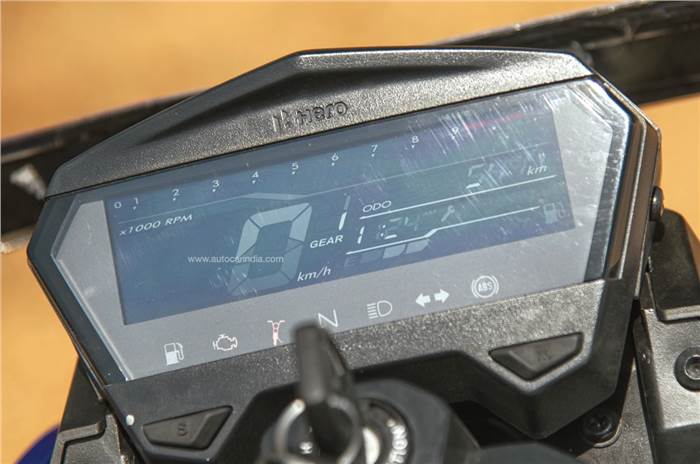
Hero’s LCD dash hard to read in bright sunlight.
The TFT and connectivity is cool, but if you like your motorcycles simple and fuss-free, you’ll prefer the lower model with its neatly executed LCD display. As for the Hero, it gets the same LCD unit from the Xtreme 160R, which, though nicely designed, is hard to read under bright sunlight.
TINY FIGHTERS
Both engines produce the exact same 11.4hp, but the Raider has a little more torque and it produces its peak power and torque at lower revs. Couple that with what feels like shorter gearing, and the Raider is the quicker accelerating bike in our tests. It also sounds more interesting with a deeper, more bassy exhaust note.
The Hero makes up ground by being even smoother than the already refined Raider and it feels noticeably less stressed at highway speeds. This is the nicer engine if you spend more time holding higher speeds. That being said, both bikes have a true top speed of just over 100kph, but the Hero has more speedo error.
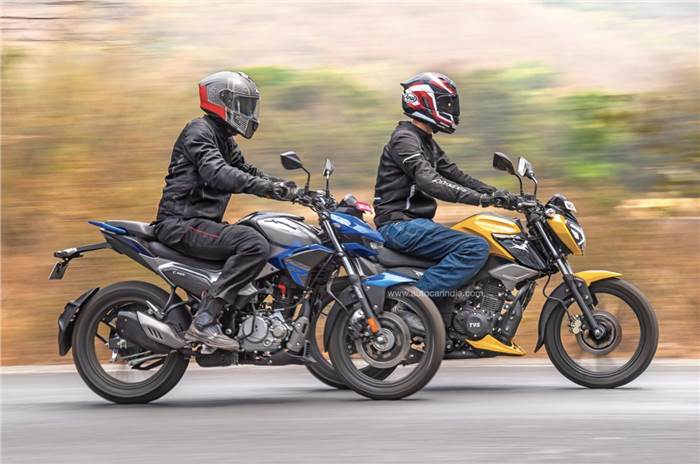
In the city, the Raider has the edge, with a more torquey nature and a lighter feel on its feet. The fact that the Raider weighs 13kg less, has skinnier tyres and comes with a start-stop system also helps it be more efficient in the city returning 57.1kpl vs 53.3kpl. However, the Hero clawed back an advantage in our highway test with 66.7kpl vs 61.9kpl.
As for the TVS’ riding modes, Eco reduces the rev limit slightly which ends up capping the top speed at 95kph. While we felt no noticeable difference in the power delivery when switching to Power mode, it does turn off the Start-Stop system. To its credit, the system works well in most situations, but you will want to deactivate it in crawling, tightly packed traffic because it keeps trying to turn the engine off.
FUN AND GAMES
As for suspension comfort, the Hero feels more soft and plush at lower speeds, but the Raider does a better job of soaking up bad roads at speeds upwards of 40kph.
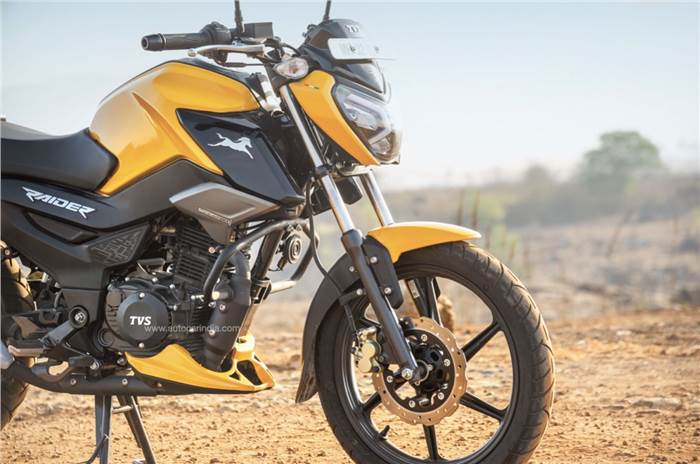
TVS suspension absorbs bad roads a little better.
With these bikes trying to look all grown up and sporty, you’d also expect them to handle well, and both most certainly do. The Raider has a delightfully light and nimble feel, but the Xtreme does a better job of feeling more like a premium 150-160cc sporty commuter. That probably comes down to its wider tyres and additional weight, but it handles with a more stable and grown up feel. It also managed to stop in a shorter distance in our braking tests.
A TOUGH CHOICE
Pricing for both bikes is pretty much on par, ranging between Rs 95,000 to just over Rs 1 lakh depending on the variant. Picking between these two is a lot harder than I thought it would be and that’s not only because they’re so closely matched but because I genuinely like them both. You could buy either of these bikes and be very happy with your decision.

The Xtreme looks and feels more like a 160.
But here’s how it goes down. The Hero is better if you want the look and feel of a bigger bike. It also comes with the valuable addition of ABS and does a little better on longer rides at higher speeds.

Raider’s motor is more peppy, but not as smooth.
As for the Raider, it manages to be quicker and more fuel efficient in the city. It also has better suspension comfort and a richer feature set. The Raider’s advantages shine brightest within urban confines and that’s primarily the environment such bikes are designed for. This is why it just about edges a logical win in this comparison, even though I enjoyed riding the Xtreme just as much, albeit for slightly different reasons. Either way, both manufacturers deserve lots of appreciation for making such likeable bikes that are still sensible and practical to buy. This is what the future of the premium commuter segment should be.
